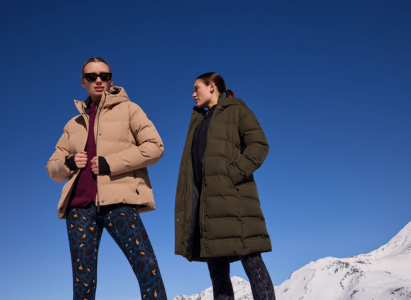
Winter has well and truly arrived, the temperatures have dropped and the wind speed has picked up, so how do you make sure you're staying warm when the weather is like this? Our latest blog is going to talk through the best way to dress for the cold British Winter.
Layering is Key In Cold Weather
The key to cold weather is layering! We see it everywhere in Winter and snow sports, but how do you bring that across to your everyday outfits? The premise stays the same, you need a base layer, some sort of mid layer and an outer layer. Each of these layers have a different role when it comes to keeping you feeling warm and comfortable.
Your base layer needs to help keep your skin dry and moisture free. Your mid layer is there to help retain body warmth. And finally, your outer layer needs to protect you from the elements.
Base layers can be something as simple as a long sleeved t-shirt and some leggings or long johns that can be worn under your pants. If you're planning on wearing a skirt and tights, your base layer bottoms can be worn under a pair of opaque tights.
The main thing you need to be conscious of when looking for a base layer is the fabric that it's made of and the fit. Avoid cotton and look for either synthetics like polyester or if you want a natural option then merino wool. They help to remove any sweat or moisture from the skin, but the base layer can't do its job if it's not touching the skin and that's where the fit comes in. The ideal base layer needs to be snug but not tight. You don't want to feel restricted in any way.
The mid layer tends to be a fleece, sweatshirt, stretch mid layer, anything that adds a level of comfort and warmth. You've got multiple choices and the warmth level can change depending on the thickness of the mid layer or the type of insulation it has.
This can also be seen as a more fashionable layer. You can choose from a full, half or quarter zip fleece or mid layer, a sweatshirt or hoodie that's a pull over style. You've got borg style fabrics to choose from, a more traditional teddy style fleece, fabric that has core stretch, something with a hood, something without a hood and don't even get us started on different colour combinations, prints and designs. You can really go all out with this layer.
Then finally you have your outer layer which is your jacket or coat. If you know that the heavens are going to open whilst you're out, then look for a coat that is waterproof as opposed to water resistant. (We talk all about the difference between the two in our ARED blog that you can read here.) Other key features to look for in your Winter coat is breathability and wind proof ratings. Having a breathable jacket helps the moisture pulled from your base layer escape and stop you feeling too stuffy. Then you've got the jacket features that appeal more to your personal choice, that includes a hood, thumb holes, sleeve cuffs, adjustable shockcord hems, zips and more. These all vary jacket to coat and don't have a massive impact on warmth but can add to the practicality of the clothing.
If you're thinking about a padded or insulated jacket as your outer layer, then it's important to be aware that different types of padded offer different levels of warmth. Down offers incredibly high standards of heat insulation but isn't great when wet. If there's a chance of rain or snow, avoid down and go for something with a synthetic padding. We use a recycled high warmth padding, look out for the phrase iLoft Ecofill when browsing our padded, puffer and insulated coats.
Don't Forget About Your Cold Weather Accessories
To complete your Winter warmer outfit, don't forget about the accessories.
You can lose a lot of heat from your head, hands and feet so make sure you're wearing appropriate shoes and socks for the weather and whatever you're doing that day. Avoid any material shoes that can get wet from a rogue puddle and don't wear cotton socks as once cotton gets wet it takes an incredibly long time to dry. Gloves are able to help provide basic warmth, you can also get insulated gloves. Mittens tend to have a higher warmth rating than gloves as your containing more body heat together with your fingers all being together rather than separated. And don't forget about a hat, not only does it retain heat, it adds another level of rain protection, especially if your hood is struggling with the wind.
If you're thinking about layering when getting ready throughout this Winter, you're going to stay as warm and comfortable as possible!






